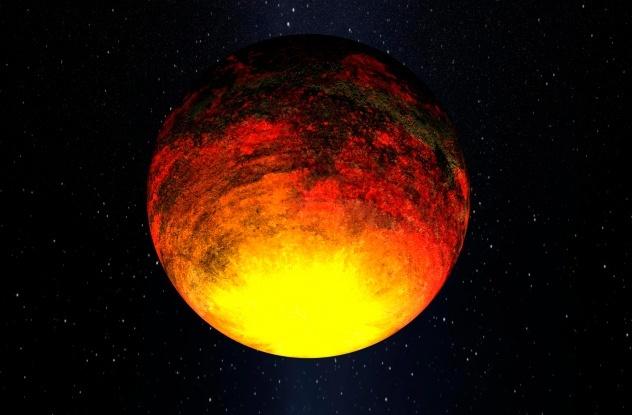10 obsolete scientific theories that didn't want to leave without a fight
 Bashny.Net
Bashny.Net

Over the past few millennia, science has changed a lot. Theories have come and gone, and many of the "facts" of the old science today would look rather strange. And although some debate was resolved fairly quickly, others dragged on for decades, if not centuries. Weird science does not want to leave without a fight. Some theories to the last defended the right to life, defying common sense.
Continental drift

Ask random people about how divided the continents, and at least a few of them will tell you about Pangaea and continental drift. In the early 20th century Alfred Wegener published his work on continental drift and the movement of land in the world. Learning about animals and plants that lived along the coast, comparing fossils and rocks, and widespread evidence like mesosaurus, freshwater reptiles that have been discovered in South America and South Africa, he came to the conclusion that it was all one big plot of land. We know the name of Pangaea, Wegener's call it the continent of Ur.
Oddly enough, in the theory of continental drift Wegener was not the most important mechanics of how it all happened. His assumptions were relatively vague, he even linked the drift forces associated with the rotation of the Earth.
The theory of continental drift seriously outdated by today's standards, and the term is now used to describe only a small part of plate tectonics. The latest theory describes that the continents are in constant motion because of tectonic plates that interact with each other. They rise and fall, converge and diverge.
Also deprecated the idea of a single dominant plot of land of Pangaea, in part. Today, scientists refer not only to the existence of Pangaea, but another supercontinent, formed 600 million years ago, under the title of Pannotia, but also one formed over a billion years ago Rodinia.
Emission theory of vision

More than 2000 years, one of the prevailing theories on the topic of vision was the theory kind of Cyclops from the "X-Men". 450 BC Alcmaeon of Croton said that vision occurs because the eye contains a "fire", sending the rays, which detect objects and back to the brain. Plato agree with him, noting that the fire is born in the eye and works with the already present light, sending images back to the brain. Plato further developed the theme of innate fire, which is present in all of us, but does not burn, but illuminates the way. All this was confirmed and physical evidence. Push down on eyes and you will see nothing like the fire that seeks to escape.
The number of doctors and scientists that subscribe to this theory, is quite impressive, including Euclid, who worked on geometry, explaining the limits of our vision, and the poet Lucretius, who described the images that we see things separate from the objects themselves, like a skin that resets the snake.
This theory remained popular until the 13th century, while the rest of the world did not begin to get translations of the writings of the Islamic scholar of the 10th century Ibn al-Haitem (aka Alhazen). Among its arguments, which put an end to the emission theory, was that when you look at the sun, eyes start to hurt. This would not have happened if the eyes were filled with rays of fire. He also argued that it would be impossible to see the stars, if we relied only on the fire of eyes; one pair of eyes could not hold so much fire. Destroying one theory, he offered his claiming that the eyes receive the information, depending on the light that gets them. This theory eventually led to the development of the modern theory of vision.
Lesage gravitational theory

Georges-Louis Lesage saw the problem the idea of gravity. Although the gravity well was used in the scale of the Universe, Lesage did not consider that the widely recognized theory of Newton could explain the force of attraction between two masses separated by huge distances in space. He developed his own theory, and although it largely debunked, still in the world are scientists who adhere to it.
The theory of Lesage claimed that gravity exists not because of direct interaction between two bodies, but on the contrary caused by what is happening with the invisible particles that fill the space between these two bodies. This space is filled with particles that move relatively freely, while the two bodies do not cast shadow on each other. Shade reduces the quantity of particles moving between two bodies as they shifted closer to each other.
The big problem with all of this, of course, is that the theory implies that the size will have a greater impact on gravity than mass. The bigger the object the bigger the shadow the bigger the attraction. Lesage avoided it, insisting that the mass represented for the most part empty space is almost the same as a relatively large area of the voids filled with loose clots of matter. The larger the object, the more blobs of mass, as clumps of mass the only thing that causes gravity shadow, it is obvious that a large object will have more influence on gravity.
Although this theory fell into oblivion together with the contribution of Einstein in the General theory of relativity, as a marginal idea she was still terribly popular. In 1954, experiments were carried out with the Foucault pendulum and the Allais effect, which allegedly led evidence in favor of the supporters of the shadow of gravity, but the scientific community remains steadfast.
Rain follows the plow

After the Civil war in the United States, the middle West, there was a massive movement, which was mainly known for its farmland and nothing else. But before the land was under cultivation — they as, however, and always has been arid and desert. Continued movement in the "promised land" was due in part to the mythology that was presented as scientific fact: rain will follow the plow.
In the 1860-ies was widespread misconception that the earlier plowing raw land raises fresh soil in the air and brings rain. Scientific fact made it Ferdinand Hayden, Director of the us geological and geographical study areas. According to Hayden, the area in the center of the country was so dry, since moisture could not get out from the soil. Plant some trees, they will return moisture into the air that will attract more rain. Others pick it up. In the 1870-ies of the Kansas Pacific Railway began to promote the idea that train tracks and power lines will attract more rain in the area. The University of Nebraska also argued that the duty of the people to work the land and release her full potential.
The result was that many people began to experience the so-called methods of "dry agriculture" in the hope that their actions will attract the attention of God and rain come. By a strange coincidence, it worked (for a while). Heavy rains in the 1870s and early 1880s years — very unusual for this area, has persuaded two million people to move to the plains. By that time, in 1887, the drought began, countless families have put everything on scientific theory-driven beliefs are not so much scientists, how many real estate agencies, owners of Railways, and others who wish to cut the jackpot on the settlers.
Even then, the idea that working with the earth causes rain, not faded. The following attempts to cause rain were already being undertaken with the use of dynamite and a belief that the vibrations from the explosions will cause rain. Even at the end of the 1930s years remained of the belief that human activity affects the weather. Ironically, today we know that this is true; just not in the way that was wanted by the farmers.
Neptunism

In Ancient Greece people knew that water has incredible power and is likely to put his hand to anything in the world. In 1770-ies of the Prussian geologist Abraham Gottlob Werner developed the theory of neptunism and dragged geological community literally fist fights, stretching on for decades.
Werner suggested that the first planet was completely covered with water. From suspended in murky oceans formed first rocks and settled to the bottom. The ocean began to recede. (Werner did not explain why). The stones settled to the bottom became dry land. As the sediments formed more and more stones, old stones eroded and placed in new locations. In the end, the mass flows washed a large surface area and formed a whole new layer of sediments. This theory was especially popular among those who tried to reconcile biblical flood of scientific knowledge, but when James Hutton formulated his theory of plutonism, there were problems.
Hutton, who was a physician, and after a farmer, manufacturer of the chemical industry and as a geologist, worked on his theory for two decades before to put it up against the theory of Werner. At its core, his theory claimed that the Earth's surface is formed under the action of natural forces, erosion, and volcanic activity. More importantly, it continues to form so far, and these processes in action we can see. He gave a deep explanation of how pressure and heat, breaking rocks as the seabed rises, as the sushi pieces carried by the wind and water and deposited in areas like river mouths. His theory he called the theory of plutonism, in honor of the Roman God of the underworld.
If we talk about who's right and who's wrong, Hatton was much closer to the truth. His work was published in 1795, but only in the 19th century Charles Lyell took up the idea, slightly cleaned, polished and rewritten.
Planet Vulcan

When astronomers looked at mercury, they could not explain its orbit. In 1846 one of the most famous astronomers have set ourselves the task to find out why mercury does not behave as expected. Urbain Jean Joseph Le Verrier was well known in his field, enjoying the fame after the computations which led to observations of Neptune. Since mercury, as it seemed to revolve a bit faster than expected, Le Verrier assumed that the game involved another planet — planet mercury. His statement that there's something there, it was met with excitement; after all, with Neptune, he guessed.
12 years he unsuccessfully sought the Volcano. While Amateur astronomer Edmond Modeste Lekabel not stated that he had seen the elusive planet on March 26, 1859. After meeting with Lakanbalen, Le Verrier decided that the astronomer does not lie. He was so impressed with the work Lakarbaia that applied for the award this man the Legion of honor to Napoleon III.
In subsequent years, the Volcano appeared where there should have been, following the calculations based on observations Lakerbaya. Meanwhile, Le Verrier became more and more sullen because of the lack of evidence of a Volcano, yet a colleague said of him: "I don't know whether Le Verrier is the most detestable man in France, but I'm pretty sure I hate it more than others". Le Verrier died on the anniversary of the observation of Neptune in 1877, but the Volcano did not wait.
During the Eclipse of 1878, astronomers across the U.S. was ready and expected to see the emergence of the Volcano. James Craig "Tubby" Watson reported that he had seen the Volcano, although others have argued that he is mistaken. Watson became obsessed with the idea so much that dug the mine, which placed the telescope in the hope that it will help him to see the bodies orbiting the Sun, in the light of day. (This idea was so ancient that astronomers already knew that it doesn't work).
Watson died before his plan to create an underground Observatory had been completed, the interest in the Volcano has dried up. 35 years later all hope to find the mysterious planet were dashed when albert Einstein explained the strange motion of mercury using General relativity.
Weightless matter

The Victorian obsession with ghosts and the occult was well known, but it was not necessary to believe in something supernatural. The ghosts consisted of something absolutely real, from the so-called odila. Odil was determined by the chemist Baron Karl von Reichenbach-like substance that is produced during the thermal and chemical reactions that replaces the place of the decaying bodies. Some people are more sensitive to it than others. Henry Morley wrote that ghosts were not something spiritual or supernatural, but rather consisted of a very real and common element. This substance was weightless and had similar properties with electricity — heat and light. In 1839, Goldring Byrd identified a "subtle matter" as a substance that fills space between other bodies. It is almost weightless and very elastic, holds light, heat and magnetic forces.
With the spread of this theory, they entered into the game, when it was necessary to explain and to describe something that defies explanation. It was assumed not only the existence of different types of weightless matter, but that the whole universe consists of it.
These theories have largely relied on the work of Newton, in which he implied the existence of the ether to explain gravity. Michael Faraday lectured on the properties of weightless matter, claiming that one of its biggest sources is the Sun. Psychologist Herbert Spencer said that studying and understanding the behaviour of weightless matter, scientists can penetrate the secrets of another mysterious region of the human consciousness.
Victorian physicists have gone even further and tried to explain the afterlife with the help of weightless matter. Balfour Stewart and P. J. Smith. Tate wrote that weightless matter was a sign that there exists an invisible world parallel to what we observe, and when our world will cease to exist, the emitted energy will be in the Universe that we do not see, but which will live.
Subsequently, there was speculation that weightless matter is nothing short of a luminiferous ether. During the Victorian era, almost all science depended on the weightless matter, but rather its solid forms, a "weighty matter." All this heresy spread in the field of economy, industry and culture.
Weightless matter has penetrated so a wide range of Sciences that it is almost impossible to say exactly when it was debunking. To 1860 years, however, physicists have redefined the concept of matter and ethereal matter slowly began to slip into the past.
The open polar sea

For centuries mankind has wondered what lies over the horizon, and the polar ends of the Earth for a long time remained the greatest secrets of the world. In the 16th century there were several scientific theories, built on what was considered scientific fact, suggesting that the North pole will be discovered the warm sea. These beliefs appeared in 1360-ies with the manuscript entitled Inventio Fortunata. It followed that a man by the name of Nicholas of Lynn sailed to the North pole and described it as a place with warm weather like in Amsterdam.
Among supporting ideas and the assumption of the British Explorer John Davis on the fact that only the freshwater environment is unable to support the presence of a huge ice chunks. As he was sure that the sea water is salty from top to bottom, it was possible to assume also that it is free of ice. Geographers also knew that the North pole is also used to heat during the summer months — and that means that any ice just had to melt along with their offensive.
The researchers and their sponsors were so confident in science the assumptions that spent a huge amount of money, trying to pave the trade routes between Europe and Asia, based on the idea of an open polar sea. British researchers have been persuaded to support this idea of Henry VIII, and although the expedition came back and talked about solid glaciers, the belief in open sea remained stable.
In 1850 an expedition, under the leadership of William Morton claimed to have found the breakdown in the ice and the open sea. Of course, nothing was detected, but it warmed up the interest to the open sea. In 1853, the American Elisha Kent Kane went in search of the British Explorer John Franklin and his crew of 128 people who went missing eight years earlier, trying to pave the North-West route between Europe and Asia. Eight years seemed rather a large amount of time, but even then there were those who believed that Franklin and his crew found refuge in the fragrant green island in the open polar sea. The latest expedition in search of the polar sea was taken in 1879, after 14 months of groveling in the present polar ice idea finally died.
The sky

For centuries, the idea of biblical theory and astronomy is inevitably tied with the idea of the firmament, the firmament. The idea of the firmament popularized writers like St. Augustine, who literally interpreted the biblical description of the creation of the Earth. According to Genesis 1:7, "And God made the expanse and separated the waters which were under the firmament from those that were above the firmament and it was so." Genesis 1:8 says: "And God called the firmament heaven".
In the writings of Augustine can be traced to the task of describing what is this firmament. First, he addressed the difference between natural waters on Earth and a kind of spiritual sea above us, but later changed his mind and described the firmament as a space extending in the air, which supports clouds on fire for him.
The idea of the firmament as the real thing has existed for a surprisingly long time and received the support of very distinguished astronomers. Copernicus wrote that although the Earth was not the center of the Universe, she was the centre of gravity to its own sphere. He also determined the distance from Earth to the Sun against the sky, writing that the space which separates these two bodies, was a mere trifle compared with the height of the firmament, which he has identified the location of all other stars in the Universe.
The first who suggested that maybe there is no giant sphere around the planet, was a German scholar of the 15th century Nicholas of Cusa. He first made the infinity of the Universe, but this was not a scientific study, and religious. In the end, God is omnipotent, why doesn't he create an infinite Universe?
However, the sky remained quite a popular idea until Giordano Bruno did not take the liberty to say that there is no firmament there. He started writing about his theories on the infinite Universe in which we are not alone. Although he did all this with the notes in his writings, there is nothing heretical, and that God can be much more powerful than just to create the firmament, he attracted the attention of the wrong people. In 1592 he was sentenced to the Inquisition for blasphemy. After seven years of imprisonment and trial, he was found guilty and was burned at the stake on 8 February 1600.
Abiotic formation of oil

Oil was well known even in Ancient Greece, when philosophers looked for ways to divide the world into four basic elements. Oil was no exception, and Aristotle wrote about their suspicion that the oil, along with other types of minerals, is born in the process of metabolism deep in the bowels of the Earth. Oil, he said, was definitely a form of (or associated with) sulfur because it smelled exactly the same.
Also distributed was the idea of abiotic (abiogenic) origin of petroleum. During the Renaissance, scientists like Georgius Agricola generally argued that bitumen and oil products are born in the process of the impact forces of the Earth into sulphur, with its subsequent condensation. This is the opposite of the idea that fossil fuel comes from organic substances. For many years this idea once dished out.
In the 19th century it was suggested that the formation of oil is similar to creating charcoal. It was known that the process involved in organic matter (this point was made by fossil evidence), but to understand how it goes to oil, it was impossible. Only in the mid-20th century, scientists had a closer look at oil. And when traces of such elements as chlorophyll, it became obvious that the oil is taken in and from a natural, once living organisms.
However, people were not ready to let go of the abiotic idea. In 1877 Mendeleev put forward the idea that when the surface water has gone into the depths of the Earth, they interacted with the metal carbides. This reaction of the formed acetylene, which subsequently condensed in the oil. While numerous studies have pointed to the fact that his idea was wrong, she found support right up to the end of 1960-ies. A number of scholars of the Soviet Union continued to support the work of Mendeleev, arguing that the only place where could be formed the oil, are the bowels of the Earth with high pressure and temperature. At the same time, the Western astronomers were inclined to the abiotic theory, arguing that, as found a lot of hydrocarbons out in space, it would be logical to assume that the Earth is made of the same materials, and thus, true to the abiotic theory. However, current evidence point conclusively in favor of the biogenic origin of oil. published
P. S. And remember, only by changing their consumption — together we change the world! © Join us at Facebook , Vkontakte, Odnoklassniki
Source: hi-news.ru
Tags
See also
If you grow old, the only way! 25 great dandies who wanted to spit on this your pension.
As English has become abnormal
The story of a boy who very much like a dog
Andrei Gnezdilov: Death like birth
Seafood that can kill us
Robert Dilts: a Mental virus
And so it really our friend China?
Results of European creative advertising competition Epica Awards 2007
Seafood: the big lie about the great benefits
Opinion about us other mirror in front of which pose almost without exception

















